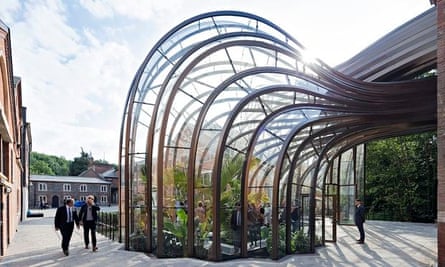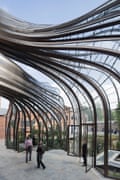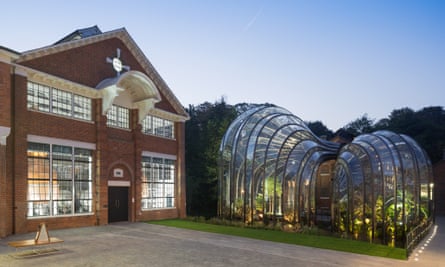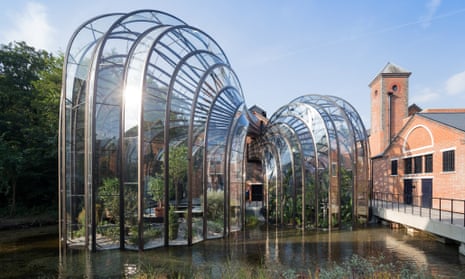They might be stocked in every swanky cocktail bar around the world, grace prime-time adverts and building-sized billboards, sponsor art exhibitions and pop-ups galore – but the final frontier in the drinks industry marketing machine comes back to the very place the stuff is made.
Letting people into the factory is now big business, an essential part of the “brand experience”. Since the Guinness Storehouse opened in 2000, it has become Ireland’s most visited attraction, while millions visit Scotland’s whisky distilleries each year to bathe in alcoholic heritage and sup from the source.
For Bombay Sapphire gin, one of the most visible brands in the world of premium spirits, a historic home has always been something of a stumbling block. The drink was only invented in 1987, and the industrial estate in Warrington where it has been distilled to date hasn’t quite lived up to the glamorous image the company wants to project.
The brainchild of marketing guru Michel Roux (the man behind the Absolut vodka ad campaigns), the blue-bottled brand was originally developed as an offshoot of Bombay dry gin, in an attempt to revolutionise the spirit’s tired reputation. It was planned to transform its dowdy image from your granny’s favourite tipple – the old “mother’s ruin” – into the sophisticated star of 90s cocktail culture. Roux’s ruse worked: only a decade after its conception, the label was snapped up by Bacardi for $300m, going on to become the world’s number one premium gin by value. And now, like some nouveau-riche celebrity, it has moved into a dream home in leafy Hampshire, brimming with all the heritage it never had.

“We wanted a place with tons of history and character worthy of the brand,” says the estate manager, Will Brix, walking between the fine redbrick buildings of the Laverstoke Mill complex, which lies on the River Test between Basingstoke and Andover. The site, he tells me proudly, has been a place of production since the year 903. It was mentioned in the Domesday Book and received five royal visits during its life as the Portal paper mill – purveyors of watermarked cotton paper to the Bank of England from 1724 to the 1990s. It is the kind of regal heritage that Bombay Sapphire (which features Queen Victoria and “from a 1761 recipe” on its label) could only dream of. So the company bought it.
With a five-acre historic campus in the bag, Bombay Sapphire employed star designer Thomas Heatherwick, conjurer of the Olympic cauldron and the new Routemaster bus, to work his magic and bring a touch of sparkle, in line with brand values. His studio spent a good deal of time whittling down the rambling complex into a coherent place, removing over 20 corrugated tin sheds and lean-to structures that had grown up around the brick and flint buildings over the years, three of which are Grade II-listed. They also did valuable work opening up the river, which had been hidden in concrete culverts, naturalising its banks with a wealth of reeds and wildflowers.

It is within this scrubbed-up heritage setting, in a central courtyard framed by classical facades, that Heatherwick’s trademark fireworks then erupt. A pair of coppery claws appear to burst through the windows of the old mill hall, splaying out in a sweeping bulge to form two gigantic glass bell-jars, before plunging into the river. It is as if the copper gin stills, now housed inside the old mill, have sprouted aerial roots, extending their tentacles outdoors in a bid to take over the site.
The forms of the glasshouses are inspired, says Heatherwick, by gardeners’ cloches, used to protect plants from the cold, and the Victorian tradition of Wardian cases, in which exotic specimens would be cultivated and displayed in genteel drawing rooms. They ooze his usual steampunk aesthetic (which here seems highly appropriate for the Heath Robinson contraptions of the distillery), while standing inside them feels like being taking into the clutches of a sci-fi spider. One tropical, the other temperate, the pleated glass domes house the 10 “botanicals”, from orris root and angelica to cassia and cubeb, that make up the unique Bombay Sapphire infusion – which can be scratched and sniffed in another room inside.
In Heatherwick’s eyes, these writhing structures are an attempt to revive some of the confidence and elegance of early glasshouses, like Joseph Paxton’s palm house at Kew and the Crystal Palace, in contrast to what he sees as the “sterility” of more recent high-tech versions. It is a worthy ambition, achieved to some extent, but the structures are comparatively chunky and rather clumsily assembled, with a proliferation of struts and braces within, compared to the slender ribs of their Victorian ancestors, which hang in diaphanous webs above your head.

Where he definitely trumps his antique predecessors is mostly invisible: this is the first distillery to achieve the environmental rating of Breeam Outstanding, the gold award for sustainability, with an ingenious range of hidden eco strategies. Heat generated by the distilling process is used to warm the greenhouses, the mill wheel has been reinstated as a hydroelectric generator, there are photovoltaic arrays and a ground-source heat pump, and the waste botanicals from the distilling process are used to partially power the biomass boiler. It only seems strange that these innovations are not formally celebrated with the same Willy Wonka glee.
For an admission charge of £15, you can wander freely through all this, ending with an obligatory cocktail at the bar, while there is a space for mixology masterclasses and plans for a restaurant and cafe to open next year. The interiors were designed by others, and have the slightly naff air you might expect from a spirit-themed visitor attraction, with a preponderance of blue-lit display cabinets and glitzy fittings – although perhaps it’s an intentionally 80s look. Either way, it’s not much that will bother you after a few G&Ts, at which point those glowing globular glasshouses will seem nothing short of miraculous.

Comments (…)
Sign in or create your Guardian account to join the discussion